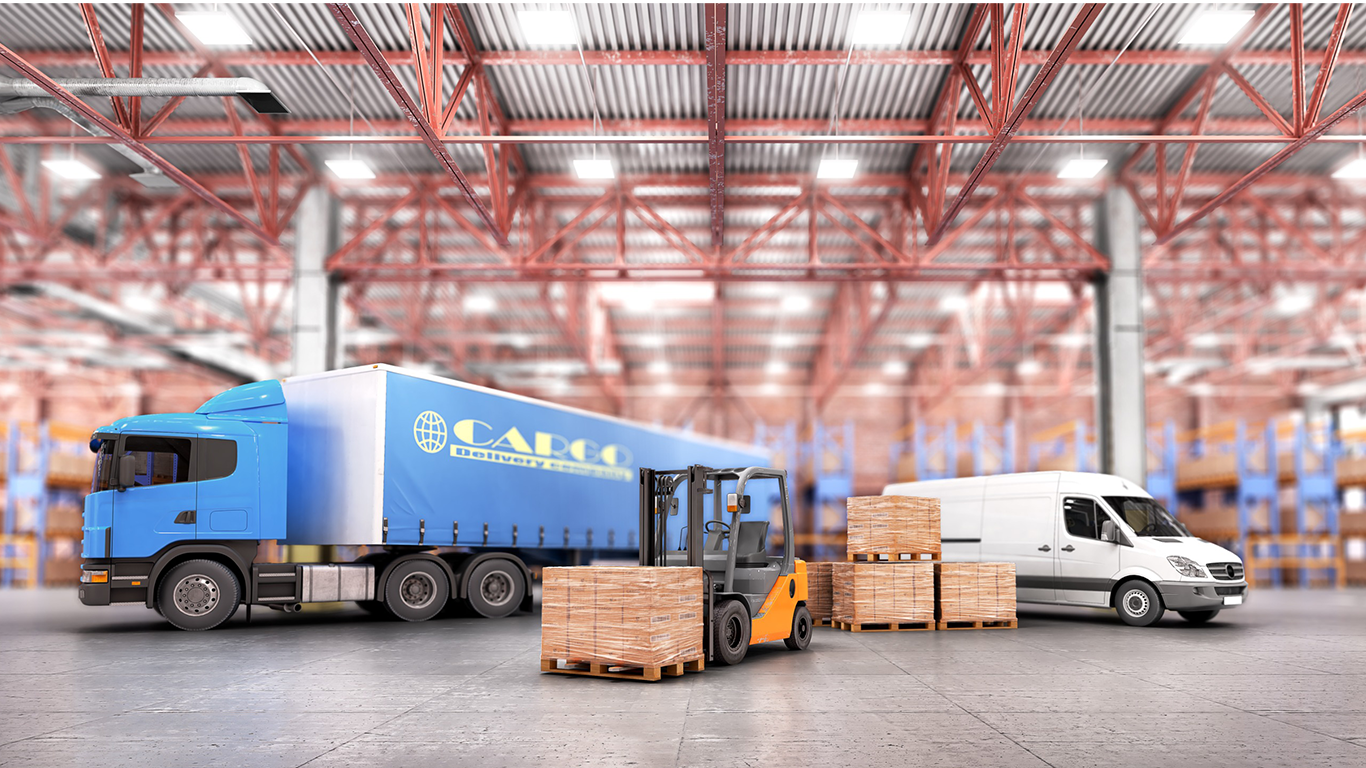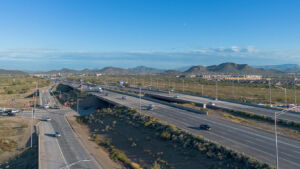Despite record supply and economic uncertainty, the distribution and warehousing sector remains resilient. While the pandemic-driven e-commerce boom is well in the rear-view, distribution still dominated the largest industrial projects delivered so far in 2024. Plus, signs of renewed activity are also evident as major logistics players lease space again with an accompanying rise in distribution support and warehousing jobs. And Phoenix is one of the strongest players in the U.S. when it comes to the distribution and warehousing sector.
MORE NEWS: Phoenix moves ahead of Silicon Valley in data center supply
Moreover, local factors — like population growth and robust logistical infrastructure — are further driving development across U.S. distribution hubs. So, to identify the most active areas, we selected the 100 largest metropolitan statistical areas (MSAs) by total distribution and warehousing square footage. The MSAs were then evaluated based on three sets of criteria: distribution and warehouse space inventory; distribution indicators and costs; and logistics infrastructure. (Read our Methodology section for a full breakdown of the metrics). We then highlighted the top 20 performers for their strengths in supporting distribution capabilities.
1. Dallas MSA
Accumulating a total of 62.2 points — seven points ahead of its closest competitor — Dallas-Fort Worth cemented its position as the leading metro for distribution and warehousing in the U.S. Specifically, the metro scored highest in three key metrics and was runner-up in a fourth with its dominance largely driven by its inventory size and rapid growth. For instance, between 2019 and 2023, Dallas-Fort Worth added approximately 110 million square feet of new distribution and warehouse space, which was more than any other metro during this period. This expansion in development boosted the metro’s total distribution and warehousing space to more than 613 million square feet, thereby securing its top ranking for overall inventory.
Situated at the crossroads of major interstate highways, the metro boasts the fifth-highest number of roads in the top 20 that are suitable for logistics with 3,449 miles of heavy roads. Its central location also allows for efficient supply chains and provides businesses the flexibility to pivot between West and East coast ports as needed. This geographical advantage is further enhanced by robust air freight capabilities centered around the Dallas-Fort Worth International Airport — one of 17 airports in the metro (the highest number among all entries in the study) — and two major inland ports.
These factors — combined with 12.3 million square feet currently under construction for the second-largest pipeline of metros analyzed — indicate Dallas’ potential to retain its top spot in distribution space well into the future. Additionally, projections suggest that, by the 2030s, Dallas could become the third-largest metro area in the U.S., further driving demand for distribution and warehousing space.
2. Phoenix MSA
In the runner-up position, Phoenix has quickly transformed into a hotbed of distribution and logistics activity. It’s also maintaining momentum with approximately 18.9 million square feet of distribution and warehouse space currently under construction to place the metro at the top of all metros for pipeline activity.
In the last five years, the metro has seen a 44% increase in its distribution and warehouse space stock to elevate it to the eighth-largest total inventory in the study. Namely, from 2019 to 2023, the region added 58.9 million square feet of distribution and warehouse space to rank fourth in percentage growth and fifth in total square footage added in the top 20.
Several factors have driven this expansion. First, the influx of hundreds of thousands of new residents has spurred demand and expanded the labor pool, attracting businesses and investments. Additionally, Phoenix’s location (only a six-hour drive from the ports of Los Angeles and Long Beach) allows goods to reach distribution centers in the West Valley on the same day. Of course, cost advantages also play a significant role with the average annual asking rent in Phoenix at $14.90 per square foot, as compared to $18.40 in Los Angeles.
3. Savannah MSA
Home to the nation’s third-busiest container gateway and one of its fastest-growing ports, Savannah, Ga., has seen its distribution profile grow at an exceptional rate in the last five years. Accordingly, the metro has experienced a 64% increase in distribution and warehouse space from 2019 to 2023 — the highest percentage growth among metros analyzed during this period. This development is driven by ongoing investments aimed at increasing the port’s capacity for larger container ships and additional cargo, along with broader geopolitical factors that have favored East Coast ports.
Furthermore, Savannah now boasts the highest share of new, more efficient distribution and modern warehouse space among its total inventory with 89% of its total stock delivered since 2000. Additionally, 83% of Savannah’s total industrial space is dedicated to distribution and warehousing — the second-highest share among the top 20 metros.
Notably, the growth trajectory for Savannah is set to continue as the metro currently has the sixth-largest amount of distribution and warehouse space under construction in the study, totaling approximately 7.1 million square feet. Similarly, port infrastructure investments are also ongoing with more than $4.5 billion in planned projects throughout the next decade. A key initiative is the Mason Mega Rail Terminal, which aims to enhance the port’s intermodal capacity and connectivity — an area where Savannah ranked fifth in the top 20 metros in rail mileage.
4. Riverside MSA
Throughout the last two decades, the Riverside-San Bernardino-Ontario, Calif., metro area — known as the Inland Empire — has evolved into a major hub for industrial real estate largely due to its growth in distribution centers and warehousing. With more than 80% of its industrial space dedicated to these uses, the metro has established itself as a sector leader. And, boasting more than 500 million square feet, Riverside holds the second-largest industrial inventory among the metros analyzed: From 2019 to 2023, the region expanded its distribution and warehouse space by 84 million square feet to position it just behind Dallas for total added square footage during this period.
This expansion has been largely driven by spillover demand from the neighboring Los Angeles metro, where industrial space has become increasingly scarce. As a result, Riverside-San Bernardino-Ontario has seen the fifth-highest amount of new industrial stock developed since 2000. The metro’s infrastructure, including 16 airports (surpassing even Los Angeles), has further supported this growth by accommodating the rising demand for same- and next-day delivery services.
However, the metro’s rapid success has brought challenges. For example, the development has led to regulatory resistance and local opposition, particularly regarding the development of distribution centers near residential areas and the effects of heavy truck traffic on neighborhoods. So, looking ahead, the future of industrial big-box developments in the Inland Empire may be influenced by advancements in building design, sustainability initiatives and the adoption of electric vehicle (EV) transportation to address community concerns while continuing to support consumer needs.
5. Chicago MSA
With a rich history and a total of 454 million square feet of distribution and warehouse space, Chicago secured its spot in the top five of our ranking mainly due to its extensive inventory and impressive supply-chain-friendly infrastructure. Here, the metro boasts 16,000 distribution-related businesses — the highest concentration in the country — and has the study’s third-largest local distribution-related labor force. Chicago’s roadway and railway networks are also extensive, ranking third and fourth, respectively, among the top 20 and further reinforcing its position as a critical logistics hub.
Yet, even as one of the largest in total warehouse and distribution space, Chicago has nevertheless seen a substantial addition of such stock in recent years: Between 2019 and 2023, the metro added nearly 61 million square feet of new space, marking the fourth-highest increase among metros analyzed. This growth was driven by sustained demand, particularly in the western and southwestern suburbs. At the same time, major projects at the CenterPoint Intermodal Center in Joliet — the largest inland port in the country — have added 4.7 million square feet across four buildings between 2019 and 2022.
Looking ahead, Chicago’s industrial pipeline remains strong with more than 7 million square feet of space currently under construction — the largest among metros in the Midwest region. Granted, like other densely populated urban centers, the challenge lies in balancing the need for last-mile delivery close to the population with the availability of land. This has led to the exploration of vertical warehouses, which is a concept long-used in east Asia. To that end, Chicago’s first multi-story distribution center, which will rise five stories high, is currently under construction, marking a new chapter in the metro’s ongoing adaptation to its growing logistics demands.




